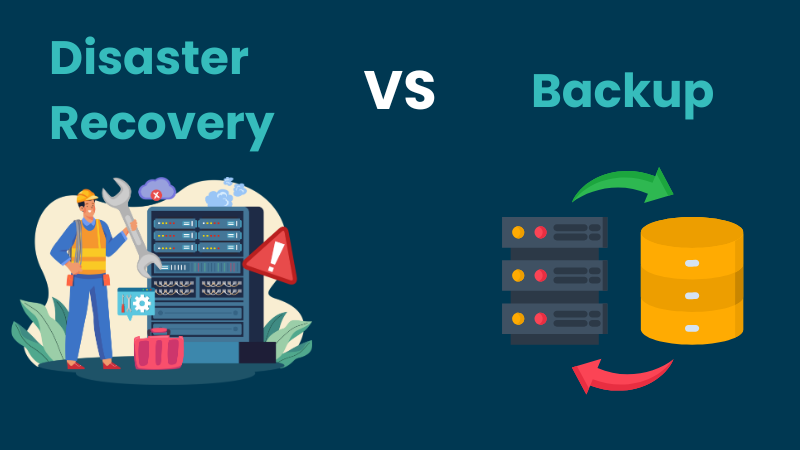Backup vs Disaster Recovery: Understanding the Difference
Stay Protected: Why Your Business Needs Both Backup and Disaster Recovery
In our data-driven world, safeguarding information is crucial for every business. When disaster strikes—whether through cyberattacks, hardware failures, or natural calamities—two key strategies come into play: backup and disaster recovery. Although they might seem similar, understanding their differences is essential to building a resilient organisation.

Backup: Your Safety Net
A backup is a copy of your data stored separately to ensure retrieval in case of loss. Regular backups protect against accidental deletions, hardware issues, and minor disruptions. By maintaining up-to-date copies, businesses can restore their data to a previous state quickly, minimizing operational impact.
Disaster Recovery: A Comprehensive Approach
Disaster recovery goes beyond data restoration. It involves detailed plans to reinstate entire systems and operations after significant disruptions. Whether facing a cyberattack or natural disaster, a robust disaster recovery plan ensures business continuity, focusing on minimizing downtime and financial loss.
Why Both Matter
While backups protect your data, disaster recovery plans ensure that your entire operation can bounce back swiftly after a major incident. Together, they provide a comprehensive safety net for your business.
Choosing the Right Strategy
Selecting appropriate backup methods and disaster recovery solutions is crucial. Consider your data volume, business needs, and potential risks. Investing in both strategies not only safeguards your assets but also builds trust among stakeholders.
Final Thoughts
In today's digital landscape, being prepared is non-negotiable. By integrating both backup and disaster recovery into your data protection strategy, you fortify your business against unforeseen challenges, ensuring long-term resilience and growth.
To learn more about the difference between backup and disaster recovery and how to protect your business, read the full article here.
For more information, feel free to 📞 call us or ✉️ email us.
Why are Cloud Costs difficult to predict?
Is On-Premises Making a Comeback?
Cloud Costs. The cloud has transformed how businesses manage IT, offering convenience for document creation, file sharing, and communication. Yet, for CFOs managing budgets, cloud expenses often feel as unpredictable as "how long is a piece of string." Unused servers and poorly managed data drive up costs, turning the cloud into an expensive IT solution.

Cloud cost unpredictability
This unpredictability is causing many businesses to rethink their cloud strategies, with some opting for cloud repatriation—moving data and services back to on-premises infrastructure. Why? Here are the key drivers:
- Cost Management: Cloud usage unpredictability and hidden fees can lead to ballooning expenses. On-premises solutions often provide better cost control.
- Performance Optimisation: Applications requiring minimal latency or high-speed processing often perform better on dedicated hardware.
- Data Privacy: On-premises storage can simplify compliance with regulations like GDPR.
- Security: Direct control over infrastructure can enhance security.
- Avoiding Vendor Lock-In: Flexibility in IT systems becomes easier when businesses aren’t tied to one cloud provider.
A 2024 Barclays survey revealed that 83% of enterprise CIOs plan to repatriate workloads, up from 43% in 2020. High-profile companies like Dropbox and Adobe have already made the shift.
But this isn’t a one-size-fits-all solution. Transitioning back requires significant investment, strong IT resources, and a clear understanding of operational complexity. Hybrid models, blending cloud and on-premises systems, are increasingly popular.
To address rising cloud costs, businesses must evaluate their workloads, utilise cost calculators, monitor expenses, and seek expert advice. Small, incremental changes can help refine strategies and predict costs more effectively.
Ultimately, whether through cloud repatriation or hybrid solutions, organisations are prioritising smarter, more predictable IT investments. Explore this evolving trend further on our page: The Challenge of Predicting Cloud Costs.
From Bulky to Brilliant: The Miniaturisation of Data Storage
Since the early days of IT, storage capacities have skyrocketed while physical footprints have plummeted. The rush to the cloud dominated the last decade, offering scalability, flexibility and data management cost efficiencies. Data centres shrank, often transforming into office spaces and IT teams were downsized.

Data Storage in 2024
Fast forward to today, and businesses heavily rely on the cloud. Storage has become far more efficient: in 2010, a petabyte of storage required 66U of rack space, 333 drives, consumed 9.3kW/hr, and cost £315,000. In 2024, the same capacity fits into 5U of rack space, uses just 940W/hr and costs £75,000, including maintenance—representing a massive reduction in space, energy and cost.
Future Data Centres
With ongoing advancements, tomorrow’s data centres could fit into a broom cupboard. Combining higher storage densities and improved performance makes localised data centres increasingly viable. Accessing local data eliminates latency and network congestion, providing unparalleled speed compared to cloud-based services.
System Reliability
Storage miniaturisation has also improved reliability. Technologies like Seagate’s ADAPT enable faster rebuilds and enhanced data protection, surpassing traditional RAID systems.
Rethinking Cloud Usage
The cloud excels in file sharing and document collaboration, but its costs are unpredictable and can be astronomical. Many businesses now adopt “cloud smart” or hybrid strategies, keeping critical data local while using the cloud selectively, saving significant amounts annually.
Falling Storage Costs
The price per megabyte has plummeted—from $7.50 in 1990 to $0.004 in 2024. This exponential drop underscores the benefits of miniaturised, efficient storage.
Performance and Productivity
Hosting data locally ensures faster access compared to the cloud, preventing productivity loss from delays. Local backups also enable significantly faster recovery in disaster scenarios.
The Future of Storage
By 2030, storage capacities will increase up to fivefold, with breakthroughs like 120TB SSDs and LTO tape offering 90TB compressed capacities. Businesses are re-evaluating the cloud’s long-term cost-effectiveness, driving renewed interest in local solutions.
Let us help you navigate this evolving landscape with tailored solutions for data management, cloud alternatives and high-performance local systems.
To find out more click the link below: https://www.fortunadata.com/articles/data-centre-miniaturisation/
